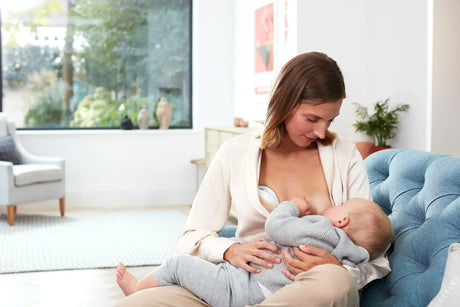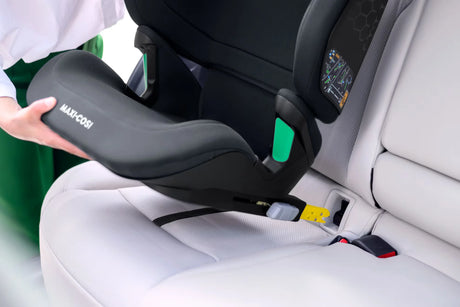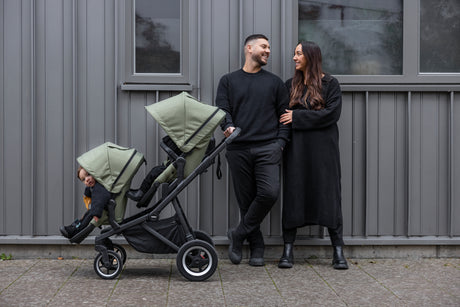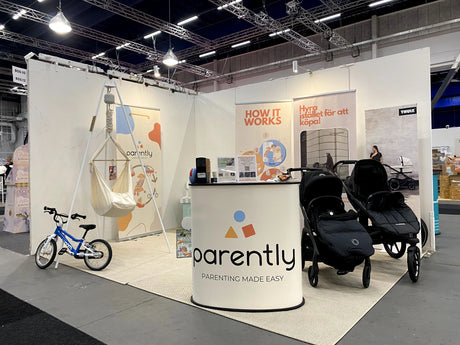Planning a trip with your little one?
Understanding how to keep them safe in the car is crucial. This guide from Parently, based on guidelines from the Swedish government, has all the information you need about different types of car seats for toddlers, how to install them correctly, when to switch to a new seat, how to care for them, and extra tips to ensure your child is safe and comfortable on every journey.
Why do we need to prioritize car seat safety for toddlers?
The Swedish Transport Agency (STA) and the Swedish National Road and Transport Research Institute (VTI) have observed that child mortality decreased by 85% since car seat safety measures were implemented. Because children have relatively fragile and unstable necks, their heads are thrown back and forth with violent force during a collision. To handle this strain, doctors and researchers have suggested that children use car seats for extra protection up to the age of 12. Swedish law also mandates that any child under 135 centimeters in height must use a specific safety device, such as a baby car seat, child car seat, booster seat, or booster cushion.
What are the different types of car seats for toddlers and their intended use?
Car seats come in four types, each designed for a specific stage of a toddler's growth, including height, weight, age, and balance.
Type 1: Rear-facing car seat

Rear-facing car seats are used by toddlers aged 7 months to 4 years. They support the child's neck, head, and spine in the event of a crash or collision and are considered the safest type of car seat.
Some of its variants are:
1. Modular car seat
These car seats are soft carriers (carrying elements) and are separated from the safety shell.

2. Easy Spin
These seats can rotate 360 degrees or have flexible rotation, making it easier to get in and out and allowing your child to sit rear-facing for a longer period.

3. Standard rear-facing seat
The standard rear-facing car seats have Isofix and are approved according to i-Size regulations.

Before purchasing, check if the car seats are manufactured according to the latest i-Size regulations.
Type 2: Forward-facing car seat

Children who outgrow rear-facing car seats move to forward-facing safety seats, which are slightly larger and face the front of the car. These seats are designed for children aged 4-10 years.
Some of its variants are:
1. Booster cushion
Booster cushions consist only of a seat portion placed under the child.

2. High-back booster seat
High-back booster seats include back, neck, and head support.

Maxi-Cosi Rodifix Pro 2 i-Size and Axkid Bigkid II Premium
Finally, you can also find convertible car seats that are both rear-facing and forward-facing, adaptable, and economical as the child grows. These seats offer a safe and comfortable option until children reach 8 years or older, according to each product's specifications.
To learn more about the differences between rear-facing and forward-facing car seats, read our article on How to Choose the Perfect Car Seat?! Rear-facing vs. Forward-facing.
How to correctly install a car seat and secure the child with the harness?
Once you have chosen a rear-facing or forward-facing car seat based on your needs, the next important step is to ensure its correct installation.
Installation steps for a rear-facing car seat, like Axkid One
1. Lower the support leg, which will be folded when the seat comes out of the box.2. Place the seat in position. Once this is done, lift the rebound bar by sliding a small lever with your thumb towards you.
3. Hold the rebound bar and secure the Isofix arms in place by pushing the safety seat into the car seat until you hear a clicking sound. As an indicator, the buttons by the Isofix arms will turn green.
4. Release the rebound bar, which will be hooked in place. Give it a little push and turn the knob on the rebound bar until you hear a loud click.
5. Lower the support leg to the floor by pressing a button at the top of the safety seat's leg. Slide it down by pressing the button until it touches the floor. Then gently press the frame until it clicks into place.
6. To install the side impact protection block:
- Align the block with the four small holes on the side of the car seat.
- Attach the block into these holes using the four small knobs.
- Secure the protection block by clicking it in place until it is firmly attached.
You can also click on this video to understand more quickly!

Steps to install a forward-facing car seat, like Axkid Bigkid 2
1. Place the seat correctly on the car's back seat.
2. Slide the lever on both sides of the seats to push out the Isofix arms. Once the Isofix arms are out, push the safety seat into the car seat until you hear a clicking sound.
3. Attach the car belt to the left arm of the safety seat.
4. Adjust the side impact protection block on the side of the car seat.
5. Finally, remove the lap belt holder that is tucked into the top part of the seat base. Adjust the booster seat's head cushion to match your child's height. Then fasten both the shoulder and lap belts securely.
To quickly understand the steps mentioned above, watch this video!
If you want a simpler installation guide for car seats, convertible rear-facing seats, forward-facing seats, high-back booster seats, and booster cushions, check out our article How to Install Different Car Seats.

Common mistakes to avoid during installation and harnessing
1. Ignore the Lever Indicator
Wait until the lever indicator turns from red to green for a safe installation.
2. Loosely Fastened Harness
Always tighten the harness; never leave it loose.
3. Using Damaged Car Seats
Only use car seats in good condition; double-check for any signs of damage.
Finally, note that the installation process varies for each model. Make sure to read the instruction manual for a clearer understanding.

When is it Appropriate to Switch from One Car Seat to Another?
Child safety in cars involves two transition steps to ensure maximum protection for your child:
Step 1
- Start with Rear-Facing Seats: These seats offer the highest safety and protection for toddlers.
- Usage Duration: Use these seats until the child is 4 years old, and sometimes even longer, depending on weight limits specified by the manufacturer.
- Weight Limits: Some seats can accommodate children weighing up to 25 kg (55 lbs), while others are limited to 18 kg (40 lbs). Swedish rear-facing seats can be used until children are 4-6 years old and can be installed in any position in the back seat.
- Transition Indicators: Switch to a larger rear-facing or forward-facing model when the child's head no longer receives adequate support.
Step 2
- Transition to Forward-Facing Seats: When the child has outgrown the weight limits for rear-facing seats, transition to a forward-facing seat.
- Usage Duration: These seats can be used from 4 to 12 years of age.
- Safer Option: A high-back booster seat ensures the external seatbelt is correctly positioned over the child's hips and thighs. You can adjust the headrest to fit the child's height, providing them with the support and safety they need as they grow.
Finally, share some simple tips for noticing transition steps:
- If the child's head sticks out over the seat or is too large to fit in the seat.
- If the child exceeds the seat's weight limit.
- If the safety seat harness no longer fits properly.
You can also refer to the article Which Car Seat Fits Your Child Best for more recommendations and insights.
Tips for Maintaining Car Seats for Durability and Hygiene!
Don't forget these tips to keep your child's car seat safe and in good condition:
Regular Inspections
- Check for Damage: Inspect the car seat for signs of damage, such as cracks, loose parts, or worn straps.
- Ensure Proper Installation: Make sure the car seat is correctly installed in your car according to the manufacturer's instructions.
- Monitor Recalls: Stay updated on any recalls for your car seat model and address any issues immediately.
Cleaning and Care
- Follow Manufacturer's Guidelines: Clean the car seat according to the instructions to avoid damaging anything.
- Spot and Deep Cleaning: Give the car seat a quick clean regularly and occasionally remove the cover for a thorough wash.
- Avoid Harsh Chemicals: Stick to mild soap and water for cleaning, as harsh chemicals can wear down the seat's material.
By regularly inspecting the car seat and ensuring it is clean and well-maintained, you can ensure it remains safe and functions well as long as you need it.
When Buying a Used Car Seat, Here’s What to Look Out For:
- Check that the seat is undamaged. Remove the cover and ensure that the shell and impact-absorbing sections are in good condition.
- Make sure all accessories and installation instructions are included.
- Finally, before renting the best car seat, check if it is approved for use in Europe with an approval number starting with 03 or 04.
Here Are Some Additional Safety Tips to Keep in Mind!
- Remember to try it out first!
- Ensure the equipment fits your child and your car. Install it correctly by carefully following the instructions.
- Don't switch your child's direction too early! Keep your child rear-facing for as long as possible, preferably until they are 4 years old.
- Double-check everything! Your child should be properly secured with the seatbelt before you drive.
- Turn off the front airbag! Make sure the passenger's front airbag is turned off if your child is sitting in the front seat.
- Car Safety: How to Protect Yourself and Your Child by the Swedish Transport Agency.
- UN Regulation No. 129: Enhancing Child Safety in Vehicles, for policymakers and concerned citizens.
- Traffic Safety for New Parents.
Educational Resources
We are here to help you!
If you still have questions after reading the article, we are happy to help! Do not hesitate to contact us at Parently (hej@parently.se), and our friendly experts will be glad to assist you with any concerns.
Finally, don't forget to check out our car seat catalog to rent a beloved product for your little one.






